Pony up—This Bunch Ain’t Workin’ For Free– Heroes For Hire #1
By Jeb D.
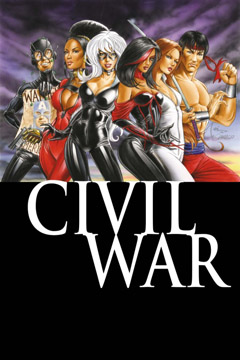 Interesting coincidence—this is the second week in a row I’ve reviewed a new #1 from the writing team of Jimmy Palmiotti and Justin Gray, penciled by an artist well known for his capabilities with the female figure (and whaddya know—both feature The Black Cat!). They’ve teamed up to bring back Marvel’s venerable “Heroes for Hire” idea.
Interesting coincidence—this is the second week in a row I’ve reviewed a new #1 from the writing team of Jimmy Palmiotti and Justin Gray, penciled by an artist well known for his capabilities with the female figure (and whaddya know—both feature The Black Cat!). They’ve teamed up to bring back Marvel’s venerable “Heroes for Hire” idea.
Luke Cage was the original “hero for hire” back in the 70’s. While a “professional” superhero wasn’t exactly a revolutionary concept, it was a clever notion that opened up some interesting approaches to comic storytelling. It was also a slyly apt bit of characterization: the notion that, in a world of white-bread spandexed heroes, the black hero was “working class.” Naturally, after the book’s sales failed to set the world on fire, Marvel retreated, dubbing Cage “Power Man” and moving him in a more conventional superhero direction. But the concept has always had potential. Now, picking up from the recent “Daughters of the Dragon” miniseries, the book is revived with a new team and new direction, linking them with Marvel’s Civil War event.
The new Heroes for Hire team is headed up by Misty Knight and Colleen Wing (the aforementioned “Daughters”), and its members range from the fairly well-known (Black Cat) to the fondly remembered (Shang-Chi) to the obscure (Humbug) to the “huh?” (Tarantula). It gives the book a very “old-school” feel, with a team assembled seemingly at random. The introductions are handled in a pretty old-school way, too, the action scenes peppered with narrative boxes and word balloons, the characters constantly calling each other by name and delivering exposition like a classic issue of The Avengers. At times the reader seems to be peeking around all the words to get a glimpse of the team in action (and the book definitely does not skimp on action).
As was the case with Joe Linsner’s work on Claws, Heroes for Hire is my introduction to artist Billy Tucci (though I’ve enjoyed reading his online column). The early preview art I saw for the series didn’t really grab me, and looking at the finished version, I suspect a lot of the book’s strength is due to legendary inker Tom Palmer. That’s not to denigrate Tucci’s work—I can see that his reputation is well-earned—but characters whose faces were indistinguishable from each other in the early previews now seem to have more depth and personality in the fully-inked version. The artwork is certainly capable, if less striking than the Linsner work I reviewed last week.
Still, Tucci’s taken on a difficult job: the book is just overstuffed with characters and backstories. On top of that, the team’s recruitment to become involved in Civil War necessitates additional extended debate over that issue with Iron Man and Spider-Man. As a result, it’s talky and busy, and any artist would have his hands full. Personally, I’d have liked to see them take a few issues to bring the various characters onboard, but I suppose the need to get them into the Civil War necessitated rushing things: tying the book’s launch into that event was probably a mistake (except, of course, from a sales point of view).
For a debut issue, it certainly covers a lot of ground. I’d say the jury’s still out on this one, but I think it may read better once it’s out from under the shade of Civil War. One thing I’ll give Heroes for Hire– unlike Claws, it’s priced at $2.99 for your 22 pages. That alone gives it a slight edge in the recommendation department.
RATING: 
Justice League of
By Graig
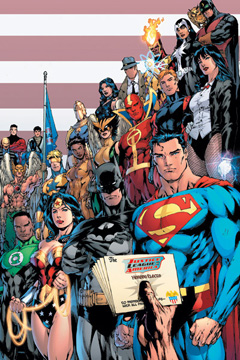 Since Thor’s Comic Column is on a weekly schedule and the blogs are capable of reacting a little more quickly to the Wednesday weekly releases, it does give us columnists a chance to scan around to gauge reactions if we wish. I tend not to do that since I don’t really want a lot of outside influences shaping my opinion of a book, but on occasion it’s just unavoidable. Justice League of
Since Thor’s Comic Column is on a weekly schedule and the blogs are capable of reacting a little more quickly to the Wednesday weekly releases, it does give us columnists a chance to scan around to gauge reactions if we wish. I tend not to do that since I don’t really want a lot of outside influences shaping my opinion of a book, but on occasion it’s just unavoidable. Justice League of
At this point I should say that if you hate Red Tornado, you’re probably not going to like the first story arc of the new JLA series, since he is the focus, and he is the centrepiece of this issue. As a character, I’ve not really had much exposure to him. I absolutely loved his Super Powers action figure when I was a kid, and I fondly recall him being a broken-down mute robot/wind elemental in an underrated series called Primal Force, but beyond that he’s not really been a star attraction in any sense. Meltzer is trying to change that, but some people don’t want to be changed. In this issue it’s noted that Tornado gets blown up a lot, and that his body always seems to come back together, and his spirit finds its way. Well, the Tornado was blown up again during the Infinite Crisis, and now his body is back in one piece, yet his spirit is in flux, and he’s consulting Deadman on his options to perhaps be human for once, to be flesh and blood for his loving wife and adoptive daughter. Batman acknowledges that Tornado is raw, untapped potential, and apparently he’s not the only one, as some sinister forces are plotting… something nefarious no doubt.
Meanwhile, as I noted, Batman, Superman and Wonder Woman are selecting a new line-up for the Justice League, and from the selections it would seem that Meltzer really wants to establish a decidedly different team than what Morrison did in his relaunch or Giffen and DeMattis did in theirs. For the first time the Justice League is mining the entire DC Universe, including other teams – the Outsiders, Titans, JSA – and trying to put together a new wave of big league hitters. I’m not wild about all their choices (Arsenal? Really? He’s been nothing but shotgun fodder for the Outsiders the past three years. Might as well call him “Bullet Absorbing Man”) at the same time there are some I love (Power Girl? Yes. Vixen? If Meltzer can bring her JLU persona into it, I’m all for it), but also it’s not exactly clear if the Trinity has come to a decision on some of them.
This first issue is a completely different change of pace from Morrison’s hyper-kinetic series over five years ago. At the same time this has an element of maturity to it, but also with that sense of wonder that should surround a flashy, spandex-clad team of superheroes. Meltzer injects a few mystery sub-plots, which should serve the present and future storylines, as well he writes some nice dialogue moments between the characters. However, I can also see why people may not respond to this: there’s no flying fists, there’s no big explosions and so far there’s no team dynamics. The Trinity are establishing a rather motley crew and surely they’re not all going to gel, but the fact that some of the characters truly are underwritten or untapped gives Meltzer a lot more leeway to develop his team than the “big seven” had.
The art by Ed Benes and Sandra Hope actually surprised me. Benes is of the 90’s Image school of art and really I didn’t think the Jim Lee/Silvestri art-style was fitting for the premiere DC super-team, and yet I didn’t hate it. The first few pages it seemed like Benes was stepping outside of his usual artistic zone and trying something new, and it looked good. The latter pages he seemed to sink back into his familiar technique, but he’s working on pulling out a new and better game. It will be interesting to see if and how he grows as the issues progress.
Overall, it may not be the exciting new chapter everyone was hoping for, but I think Meltzer has the chops to at least make it interesting. The fanboys just need to give Red Tornado a second chance.
RATING: 
Foggy’s Not Dead? Shhhh… It’s a “Secret”. Daredevil #88
By Jeb D.
 The last time Ed Brubaker did a fill-in issue with a guest artist on one of his books it was Captain
The last time Ed Brubaker did a fill-in issue with a guest artist on one of his books it was Captain
The title, of course, is designed to mislead. Foggy’s “secret” is not some kind of second identity or undercover work: it’s the “secret” life he’s had to lead, keeping Daredevil’s counsel through the crimefighter’s tumultuous career. The story is a brilliant portrayal of the life of a superhero’s sidekick.
Hiding in Witness Protection, Foggy’s haunted by the memories of all that he’s faced in his years at Matt Murdock’s side, and tormented by the guilt of letting his best friend continue to believe that he’s dead. Worse than that, it seems that knowing who to trust when in hiding is no easier than it was on the outside, and he’s caught between some very dangerous foes. Brubaker piles on the intrigue, and while this is a great stand-alone issue, it’s also developing the title’s overall storyline.
David Aja’s a relative newcomer to American comics (he also has a Wolverine story written by David Lapham due later this year), and it would appear that Brubaker’s found himself another terrific collaborator. Maybe it’s Frank D’Armata’s coloring (which I still find too dark, pretty much across the board), but Aja’s work seems to blend elements of Captain America artist Steve Epting with regular Daredevil artist Michael Lark. The action set pieces are dark and dangerous, and he makes Foggy’s terrified escape through a second-story window every bit as gripping as the book’s climactic battle. His trip through Foggy’s memory of his years with Daredevil makes it look like he’s been drawing the character all his life, and I’d love to see him back someday.
I’ve never particularly been a fan of Iron Fist, but after seeing what Brubaker and Aja do with this one-shot collaboration, I’m definitely looking forward to seeing them together on his new series.
RATING: 
![]()

Strange Killings: Necromancer TPB
(Avatar)
By Mark Wheaton
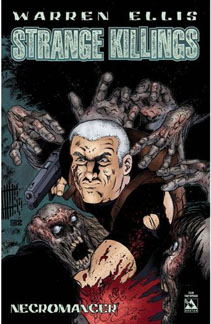 With everybody doing zombie books these days, why not Warren Ellis? Along with “Black Gas,” Ellis tackled another zombie tale for Avatar in “Strange Killings: Necromancer” that is just now making its debut as a trade paperback. It’s above average compared to a lot of the other undead fare in the marketplace (including “Black Gas” itself), but is still somewhat pedestrian when put alongside Ellis’s usual fare, which – with “Jack Cross” and “Desolation Jones” (and just a smidge of “Simon Spector”) – has been featuring a lot of disgruntled-yet-highly-effective covert ops men who may be a little better at their job than the next guy for a reason.
With everybody doing zombie books these days, why not Warren Ellis? Along with “Black Gas,” Ellis tackled another zombie tale for Avatar in “Strange Killings: Necromancer” that is just now making its debut as a trade paperback. It’s above average compared to a lot of the other undead fare in the marketplace (including “Black Gas” itself), but is still somewhat pedestrian when put alongside Ellis’s usual fare, which – with “Jack Cross” and “Desolation Jones” (and just a smidge of “Simon Spector”) – has been featuring a lot of disgruntled-yet-highly-effective covert ops men who may be a little better at their job than the next guy for a reason.
Sergeant William Gravel, the “combat magician” who has anchored Ellis’s “Strange” books for Avatar, finds himself sent to the Philippines to stop an American journalist from investigating a nasty series of missing tourists on a remote island. The Dr. Moreau-by-way-of-“Zombi” isle is run by a Dr. Thomas Edgeworth who has been doing top secret “biochemical research” for the British government and Gravel’s handlers don’t want people snooping around. Of course, there’s much more to it than that with the inevitable (and unenviable) result being that Gravel finds himself in a dense jungle fighting it out against legions of naked, bloodthirsty zombies who want nothing more than to eat people and have animalistic sex (?!).
Of course, Gravel quickly becomes the protector of the super-hot blondie journalist he’s meant to assassinate (they screw instead) as they trek across the island looking for an escape.
“Strange Killings: Necromancer” has all the touchstones of a great, Italian, z-grade zombie sleaze-fest from the seventies – from the copious nudity and zombie-sex (even Gravel almost “gets a piece” from a randy undeadite) to the guns a’blazing action and over-the-top grotesquery. As a black-and-white comic (with some groovily exploitative art from Mike Wolfer) though, it never really feels anything more than a B-level, backburner Ellis book – an author who is capable of far more, though admittedly it is somewhat neat to see what he does in this space.
Basically, “Strange Killings: Necromancer” is a fun, breezy read best suited to a trade paperback – a little fluffy, a bit tossed off, but ultimately a decent little horror-adventure story.
RATING: 
Walt and Skeezix, 1923 & 1924 volume 2
(Drawn & Quarterly Books)
By Elgin Carver
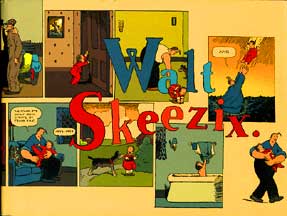 Charles Dickens’s books did not begin as "books" but episodic newspaper serials. Today, after they have been collected and republished in book form, his works make up much of the base for the form and study and enjoyment of the English novel. The intelligentsia have generally relegated the comic strip to the status of "pop art", a secondary and lesser work in quality and worth. There are works which deny that status by their very presence, but have not broken the barrier of snobbery mainly due to their unavailability. At the top of the heap one must place Krazy Kat, which despite its unavailability has kept its place in the consciousness of both fans of comics and lovers of great art. Fantagraphics Books, one of the greatest publishers for comic fans that has ever existed, is struggling to bring everyone that great strip. Joining them is an equally great strip by an equally great publisher. Frank King began Gasoline Alley in 1920 and placed an orphaned child in the hands of a bachelor mechanic in 1921, beginning the longest running story in the history of the comic strip, and perhaps of human history.
Charles Dickens’s books did not begin as "books" but episodic newspaper serials. Today, after they have been collected and republished in book form, his works make up much of the base for the form and study and enjoyment of the English novel. The intelligentsia have generally relegated the comic strip to the status of "pop art", a secondary and lesser work in quality and worth. There are works which deny that status by their very presence, but have not broken the barrier of snobbery mainly due to their unavailability. At the top of the heap one must place Krazy Kat, which despite its unavailability has kept its place in the consciousness of both fans of comics and lovers of great art. Fantagraphics Books, one of the greatest publishers for comic fans that has ever existed, is struggling to bring everyone that great strip. Joining them is an equally great strip by an equally great publisher. Frank King began Gasoline Alley in 1920 and placed an orphaned child in the hands of a bachelor mechanic in 1921, beginning the longest running story in the history of the comic strip, and perhaps of human history.
For 75 years the daily activities of the inhabitants of Gasoline Alley have been recorded in one long narrative. The actors have aged on the same pace as the readers, taking everyone along the path of childhood, adolescence, adulthood, and old age; through the depression, a world war, marriage, death, births, and all the other vagaries that life in the 20th Century has brought the common American. Every young writer wants to create the "Great American Novel". They are too late, as Frank King put it together over the past 75 years, carried on today by Dick Moore . Here the plain story of American culture, the graceless day to day life of everyman, told not just in the common idiom, but in that most American of art forms, the comic strip, is portrayed in detail, over a period of generations, like no other work in existence. The warp and woof of family and community slowly grows and makes itself a part of the reader, drawing the reader into it the way only great art can.
If this book has a fault, it is that the size is somewhat less than might be desired. The original strips were printed almost twice the size as they are reproduced here. We can only hope that when the Sunday strips begin to be collected (and the Sunday strips are, if anything, better than the dailies) it will be possible to see them at a size closer to the original. But on the positive side, deep and voluminous analysis and background reading is included. The publication of this strip is a labor that deserves both praise and reward. Every fan that feels comics have never received the credit they so richly deserve can push the artform up the ladder one more rung by supporting this series. Buy your copy immediately and urge everyone you know to buy as well. Buy gifts for the family, for birthdays, and Christmas. Your grandparents would love a copy. The local library would appreciate a donation of a copy. Buy and know that not only will you and others enjoy what they read, but American pop culture will be advanced and preserved.
RATING: 
![]()

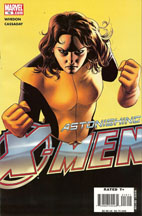 Astonishing X-Men #16 (Marvel). Kitty to the rescue! The rest of the X-Men are still incapacitated, psychically and physically, leaving the plucky Ms. Pryde to face the Hellfire Club on her own. Meanwhile, Ord and Danger have made their escape from their orbiting prison, and are headed to Xavier’s for a reckoning. The resourceful Kitty takes on Emma Frost in a clever and nicely-laid out sequence, Wolverine’s mental state just gets creepier (and funnier) each issue, and two major revelations make it clear that the final year’s worth of this book will deliver a heapin’ helping of first-rate spandexed entertainment. Joss Whedon uncorks another terrific mixture of humor and action in this issue, and John Cassaday and Laura Martin continue to make this the best-looking X book since…. well, maybe ever. – Jeb D.
Astonishing X-Men #16 (Marvel). Kitty to the rescue! The rest of the X-Men are still incapacitated, psychically and physically, leaving the plucky Ms. Pryde to face the Hellfire Club on her own. Meanwhile, Ord and Danger have made their escape from their orbiting prison, and are headed to Xavier’s for a reckoning. The resourceful Kitty takes on Emma Frost in a clever and nicely-laid out sequence, Wolverine’s mental state just gets creepier (and funnier) each issue, and two major revelations make it clear that the final year’s worth of this book will deliver a heapin’ helping of first-rate spandexed entertainment. Joss Whedon uncorks another terrific mixture of humor and action in this issue, and John Cassaday and Laura Martin continue to make this the best-looking X book since…. well, maybe ever. – Jeb D.
RATING: 
 DMZ #10 (Vertigo) – The “Body of a Journalist” arc ends in gripping fashion this month as military forces begin massing for an invasion of Manhattan and the first few missiles fly – slamming into the skyscrapers with disastrous result. Reporter Matthew Roth and his comrades are resigned to the fact that the invasion is coming and the scenes of residents descending into communal bomb shelters couldn’t feel more timely with the recent Israel-Hezbollah conflict and its various rocket barrages against civilian targets. While below, Roth meets another reporter who has slipped into the DMZ who offers to help send his recorded evidence to the world that the Army killed the kidnapped journo Viktor Ferguson (the titular “body of a journalist”) in cold blood in order to spark the invasion – shades of the Nazis who propped up “Polish” soldiers to shoot at a German radio station in order to falsely precipitate the Wehrmacht sweeping in. But just as he’s about to broadcast, the Army makes him an offer he finds hard to refuse. The writing here in issue #10 is definitely on point with an incredibly satisfying conclusion to a complex arc. What’s interesting is that the end of the issue does little to resolve the stand-off at work in the series, so it will assuredly get worse before it gets better. Good. Writer Brian Wood and artist Riccadro Burchielli seem to have hit their stride on “DMZ” after a couple of hiccups setting up the world, so it could be rather exciting to see what comes next. –Mark
DMZ #10 (Vertigo) – The “Body of a Journalist” arc ends in gripping fashion this month as military forces begin massing for an invasion of Manhattan and the first few missiles fly – slamming into the skyscrapers with disastrous result. Reporter Matthew Roth and his comrades are resigned to the fact that the invasion is coming and the scenes of residents descending into communal bomb shelters couldn’t feel more timely with the recent Israel-Hezbollah conflict and its various rocket barrages against civilian targets. While below, Roth meets another reporter who has slipped into the DMZ who offers to help send his recorded evidence to the world that the Army killed the kidnapped journo Viktor Ferguson (the titular “body of a journalist”) in cold blood in order to spark the invasion – shades of the Nazis who propped up “Polish” soldiers to shoot at a German radio station in order to falsely precipitate the Wehrmacht sweeping in. But just as he’s about to broadcast, the Army makes him an offer he finds hard to refuse. The writing here in issue #10 is definitely on point with an incredibly satisfying conclusion to a complex arc. What’s interesting is that the end of the issue does little to resolve the stand-off at work in the series, so it will assuredly get worse before it gets better. Good. Writer Brian Wood and artist Riccadro Burchielli seem to have hit their stride on “DMZ” after a couple of hiccups setting up the world, so it could be rather exciting to see what comes next. –Mark
RATING: 
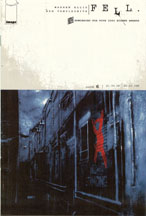 Fell #6 (Image) opens with my favorite line from any comic this year: laugh-out-loud-while-reading-on-the-train stuff. From there, the story moves to the awkwardly growing friendship between Rich Fell and Mayko, then turns grim and darker with an unexpected police call, descends into a true vision of hell, and ends with a version of justice, and the promise of a deepening storyline to come… all this in 16 gripping pages. Fell continues to be a modern marvel: each time out, for your two bucks, writer Warren Ellis delivers a complete, dense, thoroughly satisfying mystery. Of course, he’s helped immensely by artist Ben Templesmith’s ability to set up the story by suggesting everything we need to know about the darkness of Snowtown and its denizens with just a few strokes. – Jeb D.
Fell #6 (Image) opens with my favorite line from any comic this year: laugh-out-loud-while-reading-on-the-train stuff. From there, the story moves to the awkwardly growing friendship between Rich Fell and Mayko, then turns grim and darker with an unexpected police call, descends into a true vision of hell, and ends with a version of justice, and the promise of a deepening storyline to come… all this in 16 gripping pages. Fell continues to be a modern marvel: each time out, for your two bucks, writer Warren Ellis delivers a complete, dense, thoroughly satisfying mystery. Of course, he’s helped immensely by artist Ben Templesmith’s ability to set up the story by suggesting everything we need to know about the darkness of Snowtown and its denizens with just a few strokes. – Jeb D.
RATING: 
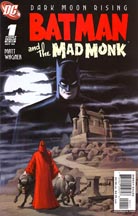 Batman and the Mad Monk #1 (DC) – After completing his run on “Batman and the Monster Men,” Matt Wagner returns with another “Year One” adventure with “Batman and the Mad Monk,” which begins almost immediately after “Monster Men” with Batman learning that Hugo Strange has gotten off for his “Monster Men” deeds. But there’s a new criminal in town – somebody with a penchant for tearing out throats and draining their victims of blood (no, not Man-Bat). The story starts slowly, tying up any loose ends from the previous series before Commissioner Gordon is even able to let Batman know what’s going on. While interesting to watch one arc bleed into another, the evocative cover art and the last few pages (where a woman is kidnapped and drugged by another woman to be bled dry for Niccolai and “the Brotherhood”) suggest a great, gothic tale afoot for Batman – that can’t help but make the rest of the book feel almost dull in comparison. Here’s hoping issue #2 ramps up the adventure. –Mark
Batman and the Mad Monk #1 (DC) – After completing his run on “Batman and the Monster Men,” Matt Wagner returns with another “Year One” adventure with “Batman and the Mad Monk,” which begins almost immediately after “Monster Men” with Batman learning that Hugo Strange has gotten off for his “Monster Men” deeds. But there’s a new criminal in town – somebody with a penchant for tearing out throats and draining their victims of blood (no, not Man-Bat). The story starts slowly, tying up any loose ends from the previous series before Commissioner Gordon is even able to let Batman know what’s going on. While interesting to watch one arc bleed into another, the evocative cover art and the last few pages (where a woman is kidnapped and drugged by another woman to be bled dry for Niccolai and “the Brotherhood”) suggest a great, gothic tale afoot for Batman – that can’t help but make the rest of the book feel almost dull in comparison. Here’s hoping issue #2 ramps up the adventure. –Mark
RATING: 
 X Isle # 1 (Boom Studios) – Boom Studios seems to have leapt into the comics scene like Diana, full grown, from the forehead of Zeus. Titles proliferate in every genre, of varying quality and varying interest. One that they seem to do better at is giant monster. This issue begins and ends with giant monsters and certainly leads us to believe that future issues will bring more of the same. Cinematic in vision and style, the art by Greg Scott looks to be "photoshopped", but that should cause little concern for potential readers, as it is well done and appropriate. The colors by Sunder Raj are excellent and add to the mood. The story by Andrew Cosby and Michael A. Nelson advances well, if overblown in some aspects. Here and there stock monster movie characters emerge, with predictable reactions, in predictable situations. Still it starts as a good read and has potential. Will the reader be led into fields unforeseen or down well worn pathways. There is real potential here. Let’s hope it goes in an appealing direction. Only time will tell, but after reading the first issue, the second is a must. – Elgin
X Isle # 1 (Boom Studios) – Boom Studios seems to have leapt into the comics scene like Diana, full grown, from the forehead of Zeus. Titles proliferate in every genre, of varying quality and varying interest. One that they seem to do better at is giant monster. This issue begins and ends with giant monsters and certainly leads us to believe that future issues will bring more of the same. Cinematic in vision and style, the art by Greg Scott looks to be "photoshopped", but that should cause little concern for potential readers, as it is well done and appropriate. The colors by Sunder Raj are excellent and add to the mood. The story by Andrew Cosby and Michael A. Nelson advances well, if overblown in some aspects. Here and there stock monster movie characters emerge, with predictable reactions, in predictable situations. Still it starts as a good read and has potential. Will the reader be led into fields unforeseen or down well worn pathways. There is real potential here. Let’s hope it goes in an appealing direction. Only time will tell, but after reading the first issue, the second is a must. – Elgin
RATING: 